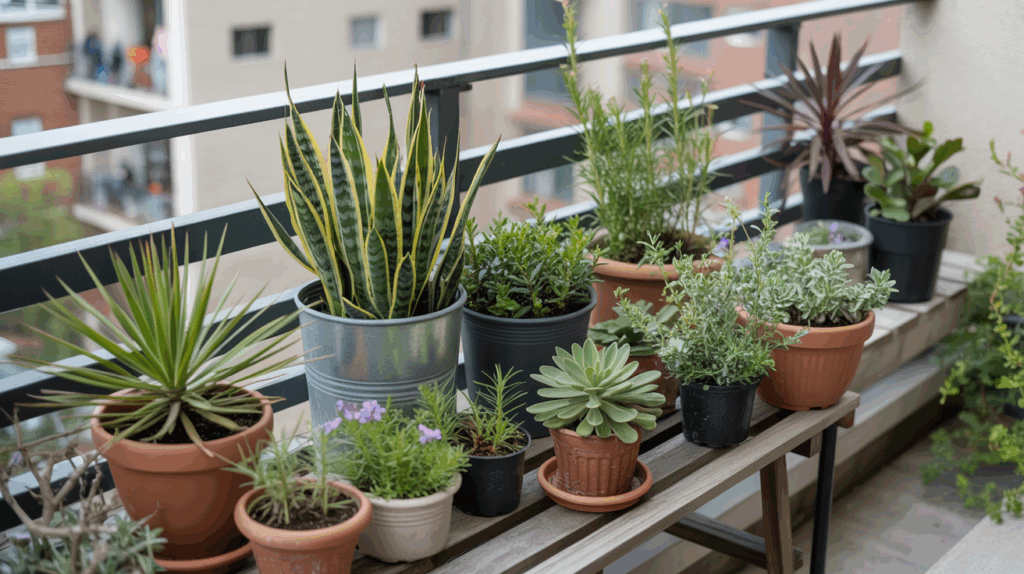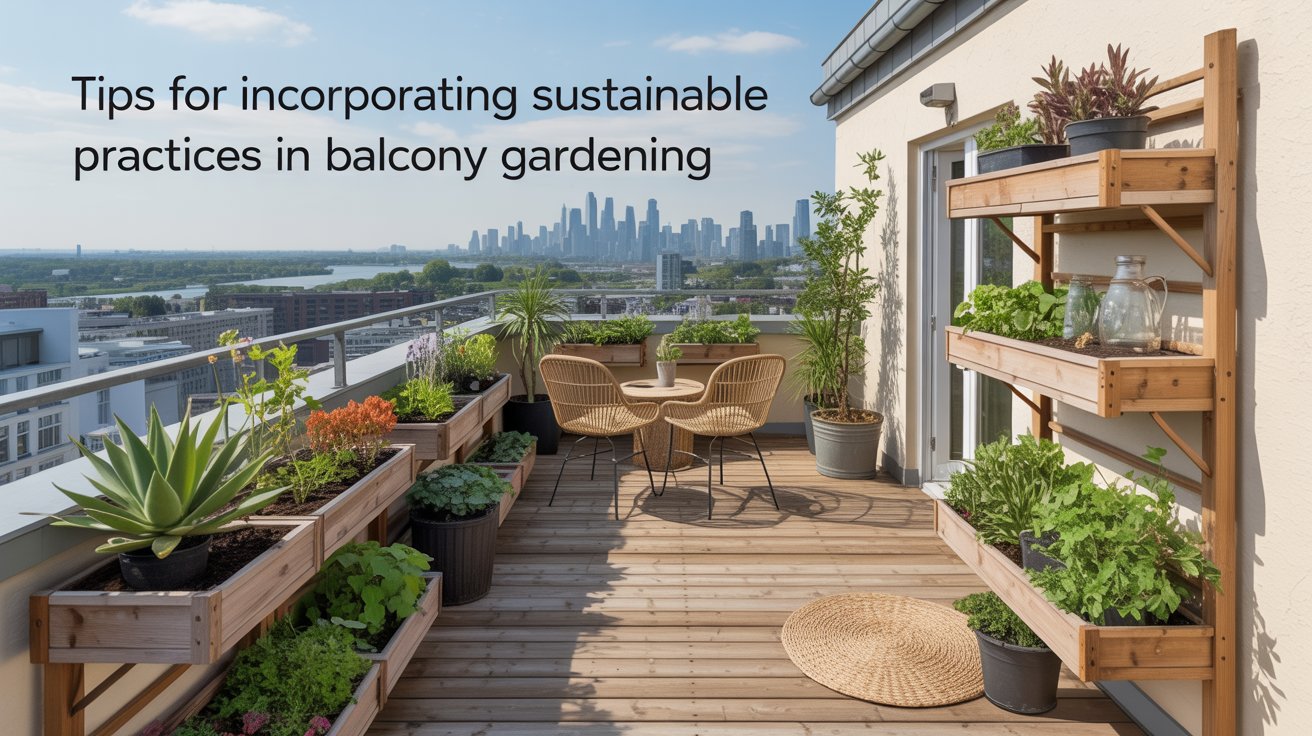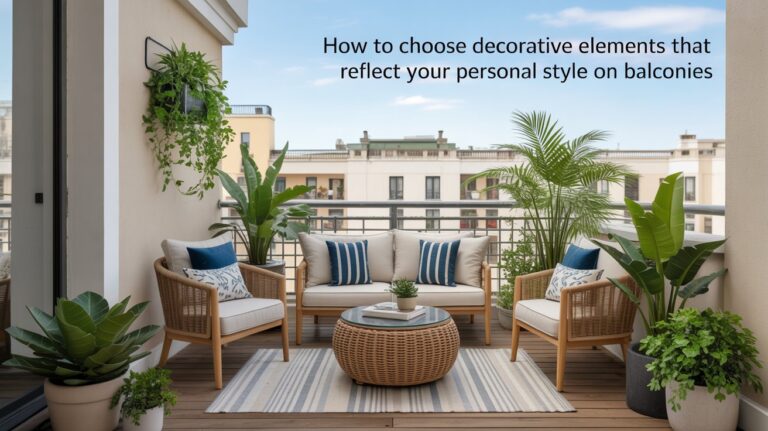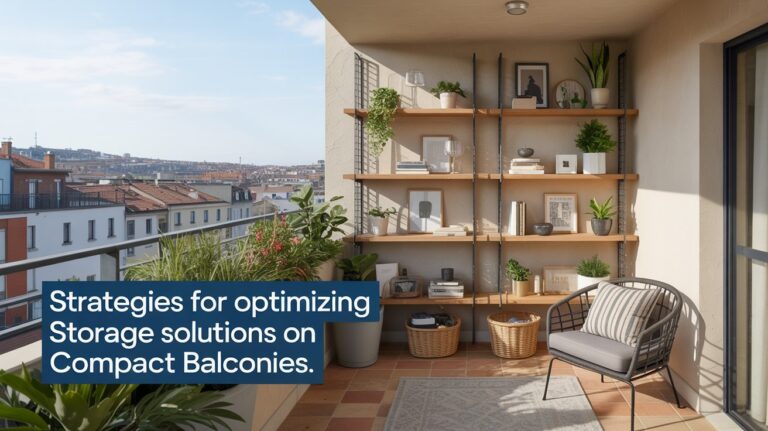Tips for Incorporating Sustainable Practices in Balcony Gardening
I have been, or can be if you click on a link and make a purchase, compensated via a cash payment, gift, or something else of value for writing this post. As an Amazon Associate, I earn from qualifying purchases. Please read my full Affiliate Disclosure for more information.
You’ll maximize space, conserve water, and boost biodiversity by choosing native, drought-tolerant plants and using compact, upcycled containers with drip irrigation. Focus on space efficiency, vertical gardening, and easy access for maintenance. Align plant placement with sun exposure and microclimates, and favor low-irrigation species with staggered bloom periods. Use mulch, soil moisture sensors, and rain barrels to tighten irrigation. Keep records and gradually test smarter media and organic inputs—more sustainable tweaks await as you go deeper.
Key Takeaways
- Design with space efficiency, vertical gardening, and multi-purpose containers to maximize balcony use while minimizing material waste.
- Choose native, drought-tolerant plants and stagger bloom periods to support biodiversity and reduce irrigation needs.
- Use drip irrigation, mulch, and soil moisture sensors to water precisely and conserve water.
- Upcycle sturdy, food-safe containers and recycled growing media, ensuring proper drainage and airflow.
- Maintain records, prune regularly, compost plant waste, and continuously adopt sustainable techniques for long-term improvement.
Selecting Drought-Tolerant Native Plants for Small Spaces
Choosing drought-tolerant native plants for small balcony spaces helps conserve water while supporting local ecosystems. You’ll compare growth rates, root depth, and sun exposure, then select species adapted to your microclimate. Native plant selection focuses on drought resistant landscaping traits—low irrigation needs, deep rooting, and heat tolerance—leading to more resilient, low-maintenance beds. You’ll assess container size, soil mix, and drainage to minimize waste and runoff. Data guides choices: water-use efficiency, seasonal bloom, and pest resistance inform your plan. This approach reduces dependence on synthetic inputs while boosting biodiversity and long-term balcony viability.

Water-Wise Irrigation and Rainwater Harvesting for Balconies
You’ll see that small-space irrigation benefits from precise water-conserving techniques, like drip systems and mulch to minimize evaporation. Rain harvesting basics show how even a balcony balcony can capture enough runoff with a compact container system to reduce reliance on mains water. By measuring soil moisture and adjusting schedules, you’ll balance plant needs with conserving resources.
Water-Conserving Techniques
Water-wise irrigation and rainwater harvesting on balconies can dramatically cut water use while keeping plants healthy. You’ll implement drip irrigation to deliver water directly to roots, reducing evaporation and runoff. Pair this with soil moisture sensors to guide timing and quantity, avoiding overwatering and stress. Data from sensors helps you schedule brief, frequent watering during heat spikes and longer intervals when conditions are cool or cloudy. Consider compact rain barrels or collapsible containers to collect rainfall for plant use, minimizing municipal demand. Regularly review hydro planograms and adjust for seasonal shifts, ensuring sustained, efficient moisture management.
Rain Harvesting Basics
Rain harvesting on balconies builds on those water-conserving practices by turning rainfall into a usable resource rather than letting it run off. You’ll optimize this by understanding volumes, timing, and system components. Key topics include rainwater filtration and gutter maintenance to prevent contamination and overflow.
- Evaluate rooftop catchment versus planter needs to size your system accurately
- Implement rainwater filtration to remove debris before storage and irrigation
- Maintain gutters regularly, inspecting for leaks, clogs, and improper slopes to ensure steady flow
Monitor rainfall data to align irrigation with plant demand, reducing waste and improving precision.
Upcycling Containers and Sustainable Growing Media
You can start with upcycled containers such as plastic tubs or jars, noting their weight, drainage, and reusability. Data shows that shredded fabric or compostable liners can improve moisture retention without sacrificing aeration, while recycled growing media choices influence nutrient availability and pH balance. Together, these options align with sustainable soil alternatives and support a practical guide to implementing the Upcycled Containers Guide, Recycled Growing Media, and Sustainable Soil Alternatives.
Upcycled Containers Guide
Upcycled containers offer a practical, cost-effective way to start balcony gardens while reducing waste; by selecting sturdy, food-safe vessels and prepping drainage, you can achieve reliable plant growth without buying new pots. You’ll assess material safety, weight, and trace contaminants, then optimize soil depth and airflow for root health. Seek durable, reusable options and document their load limits to prevent cracking. 1. Inspect containers for cracks and residues. 2. Add breathable inserts and proper drainage. 3. Label with plant type and watering needs. recycled planters and eco friendly containers support data-driven decisions, sustainability, and site-specific results.
Recycled Growing Media
Balanced growing media matter just as much as sturdy containers. You’ll find recycled materials can deliver consistent porosity and drainage when you mix locally sourced options with measured amendments. Data suggests that shredded coconut coir, composted bark, and recycled paper blends improve water retention without compaction, increasing root oxygen by a reliable margin in balcony volumes. Track moisture and salinity to avoid buildup, adjusting using composting methods and safe feeds. Prioritize organic fertilizers that align with your media, supporting gradual nutrient release. This approach minimizes waste, reduces costs, and supports plant health with evidence-based, practical, apartment-friendly techniques.
Sustainable Soil Alternatives
Sustainable soil alternatives start with upcycling containers and selecting media that maximize porosity, drainage, and nutrient delivery without increasing waste. You’ll improve structure and waterholding capacity by choosing organic composting inputs and nutrient-rich blends, reducing need for synthetic amendments. Observe how container shape and material affect root growth, evaporation, and temperature, then measure outcomes with simple notes on plant vigor. Aim for soil enrichment that supports beneficial microbiology while minimizing waste streams.
- Upcycle containers with drainage and aeration
- Mix sustainable media prioritizing porosity and organic matter
- Incorporate composting-derived amendments and monitor results
Maximizing Sunlight and Microclimates on Balconies
Balconies vary in light and warmth, but you can optimize both by mapping sun exposure across the day and adjusting plant placement accordingly. You’ll observe pattern consistency by recording hourly sun spots and shading from nearby structures. Use this data to cluster microclimates on your rail, floor, and planter levels, then assign species with matching light needs. Balcony microclimates emerge from height, orientation, and reflective surfaces, while sunlight optimization depends on timely pruning and movable screens. Track growth metrics alongside light hours to refine layouts over seasons, enhancing efficiency and resilience without excess resources.
Supporting Biodiversity With Native Pollinator-Friendly Options
What concrete steps can you take to support biodiversity on a balcony with native, pollinator-friendly options? You’ll tailor plantings to local conditions, prioritizing native bee habitats and drought-tolerant choices. Monitor bloom periods, selecting pollinator friendly flowers that stagger nectar supply. Avoid monocultures; diversify heights and textures to create microhabitats for insects, birds, and beneficial arthropods.
- Plant a mix of natives that bloom at different times, ensuring continuous forage.
- Combine flowering perennials with seasonal annuals to extend resource windows.
- Provide shallow water sources and sheltered refuges to support nesting and resting.
Data suggests richer pollinator activity correlates with habitat variety and consistent water access.
Energy-Efficient Tools and Low-Waste Gardening Practices
Energy-efficient tools and low-waste practices can meaningfully cut both water and energy footprints on a balcony. You’ll notice that small, precise actions yield measurable gains: using solar powered gadgets reduces grid demand, while programmable timers minimize unnecessary watering. Data shows soil moisture sensors can cut irrigation by up to 30 percent when paired with drought-tolerant plant choices. Choose composting methods that fit your space and climate, like bokashi or compact bins, to close nutrient loops without odors. Prioritize multi-use tools, durable materials, and proper bin placement to maximize efficiency and minimize waste. Continuous tracking helps refine routines over time.
Conclusion
In short, your balcony can be a model of efficiency and biodiversity. Observing plant growth data, you’ll notice drought-tolerant natives thrive with minimal irrigation, while rain harvests reduce utility demand. Upcycled containers cut waste without compromising yield, and thoughtful placement boosts sun exposure for healthier crops. By prioritizing pollinator-friendly options, you’ll support local ecosystems. Pair energy-efficient tools with low-waste routines, and your sustainable balcony garden becomes a measurable, repeatable approach you can confidently scale.






